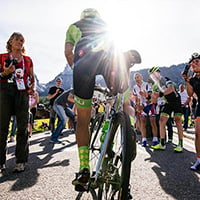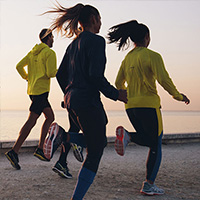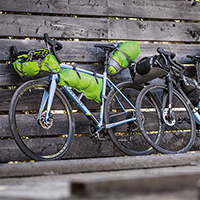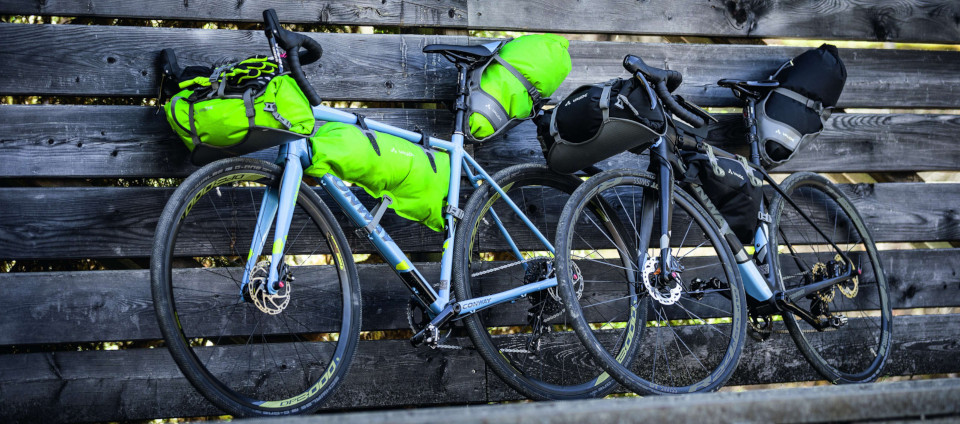
BIKEPACKING GUIDE
Unless you’ve been living under a rock for the past couple of years, you’ll probably have read a thing or two about bikepacking – essentially lightly-loaded, multi-surface bicycle touring. Perhaps you’re curious to try out this newer style of bike travelling or just interested to find out more. We’ve put together this handy guide to shed some light on this popular modern cycling trend, the gear you need to do it as well as some handy tips to make things a bit easier.
Bikepacking vs. touring – what’s the difference?
Before we go any further, let’s deal with the elephant in the room and the first question most people ask when discussing bikepacking: what’s actually the difference between bikepacking and touring? Or, simply, is there actually any difference between bikepacking and touring?
Well, yes and no. Generally-speaking, bikepacking and touring are both about doing longer multi-day trips on the bike. Most typically, bike touring takes place on the road, using a more traditional set up of panniers and a handlebar bag while bikepacking takes in singletrack trails, gravel and dirt roads.
Think of it this way – bikepacking allows you to go where a traditional touring bike/setup would be out of its depth.
Disclaimer
Although ‘bikepacking’ is now often used as a catch-all term for both on and off-road touring, many people believe that bikepacking is exclusively an ‘off-road’ pursuit.
Gear: bikes, bags & tyres
What do you need to go bikepacking? Well, essentially you need a decent bike and some bags. But it’s not quite as simple as that. Let’s start by having a look at what kind of bikes people typically use for bikepacking.
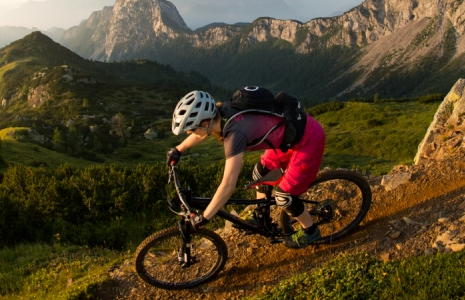
Many purists believe that bikepacking means riding a mountain bike. Although we don’t exactly share this opinion, we can’t deny that mountain bike tyres make it easier to handle rougher terrain.
Having suspension also makes even wilder landscapes accessible, although comes with an obvious weight penalty. For this reason, many people see fully rigid mountain bikes as the ideal bikes for bikepacking– they can run big tyres but are still lighter and more agile than mountain bikes with suspension, as well as much more efficient on paved roads.
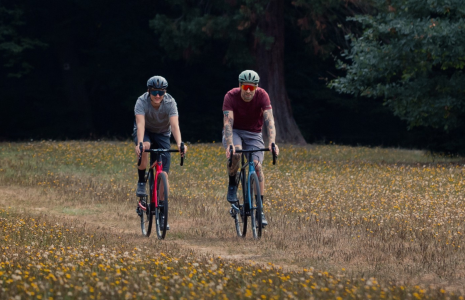
For many riders, the gravel bike is the go-to bikepacking bike, truly representing the best of both worlds. With geometry borrowed from cyclocross and road bikes but adapted for longer days in the saddle, together with tyre clearance that rivals early mountain bikes, gravel bikes are versatile, capable on and off road and stout enough to handle the rigours of demanding terrain.
No bike will be able to do everything well, but if your rides are a mix of tarmac, gravel and mild single-track, a gravel bike with fat tyres might be perfect for you.
It’s very important to have the right tyres for the terrain you ride. If you intend to ride purely off road and don’t anticipate any tarmac whatsoever, a pure
mountain bike tyre is best. Think carefully about tyre width and the maximum tyre size your bike’s frame can accommodate. Remember, wider/bigger tyres are heavier and less agile. If it’s going to be wet, think about a tyre with deeper tread.
If you’re going to mix road and off road, a lighter cross-country mountain biking tyre or dedicated gravel tyre are both good options – the latter are designed to roll fast on the road but also offer enough grip and traction for moderate off-road riding.
Bags
Manoeuvrability, durability and weight are the three most important factors to consider when choosing bikepacking bags. In contrast to panniers used for touring, bikepacking bags keep the weight closer to the bike, making use of the space in and around the frame to transport stuff. They also mean you can do away with the heavy metal racks that are used to affix panniers.
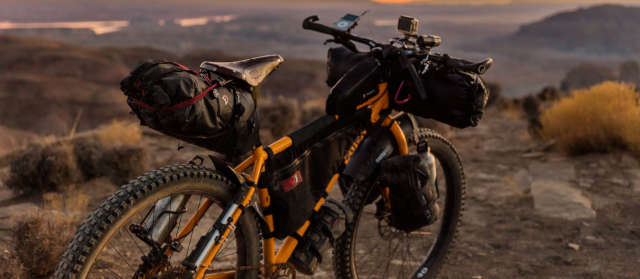
Seat bags
Seat bags attach to your seat post and the rails of your saddle, enabling you to carry stuff aerodynamically and closer to the bike’s centre of gravity than with traditional rear panniers. They come in a variety of sizes, from around 5 litres right the way up to around 18 litres, so you can find exactly the right size for the type of trip you want to do. Bear in mind that better models usually have a tensioning system that prevents the bag from flapping around too much. Some models are fully integrated, while others have a cradle system you clip a dry bag into. Also check to see if the model you’re buying is waterproof or just water resistant – the latter will require you to put your stuff in a dry bag if you need to ensure it stays completely dry.
Frame bags
Rahmentaschen sind super, um den ungenutzten Platz innerhalb des Rahmen-Dreiecks ideal zu nutzen. Modelle gibt es in allen erdenklichen Größen. Bedenke, dass vollgefederte Mountainbikes durch die Federsysteme meist nur über sehr begrenzten Platz am Rahmen verfügen.
Handlebar rolls/packs
Carrying stuff at the handlebars is also very common, especially sleeping gear. Several companies make bags that strap to the handlebars and are perfect for carrying your sleeping stuff or tent. Bear in mind that if you’re riding a drop bar bike, space at the handlebars will be more limited than a flat mountain bike handlebar. A ‘handlebar roll’ can also interfere with the function of your gear/brake levers on a drop-bar bike if not positioned properly.
Additional luggage possibilities
Bikepacking is all about using as much space on the bike as possible: additional ‘feed packs’ that attach to the stem and carry snacks or drinks, small bags that attach to the top tube and even bags for mounting on the forks are also common.
Some priceless bikepacking tips
There are no hard and fast rules for bikepacking, but here are a few things we’re learned over the years:
- Bring less than you think you need – this makes your bike lighter and more agile. This applies particularly to clothing.
- Check your tyres and make sure you have spare tubes and a patch kit. The last thing you want is to have to walk 25km out of the wilderness or hitchhike to the next town.
- A working GPS device, maps & batteries: this is common sense, but getting lost in the middle of nowhere is no fun. If you’re using your mobile phone, make sure you have a backup battery pack and the map downloaded!
- Keep your stuff dry – for obvious reasons! Dry bags are cheap and will save you a lot of stress if it rains. Getting wet also means getting cold quicker!
- Think carefully about your water. Can you transport enough on your bike? Are you riding somewhere hot? Perhaps you need a portable water filtration system or a backpack with a bladder to stop you running out of water. Remember, cooking can also require a lot of water.
- Gear low! Riding off-road, uphill and on rougher terrain can be extremely tough on the legs and knees. Make sure you have the right gearing on your bike!
- Pack your seat pack with heavier stuff nearer the seat post to stop the bag wagging around. Think carefully about where you’re going to pack heavy, bulky stuff like a camera or stove. Keep bulkier stuff closer to the bike’s centre of gravity
- If you’re bringing cooking gear, go titanium. It’s more expensive, but the lower weight and durability are worth it!
- (Merino) wool clothing is great for bikepacking trips. It regulates body heat well, doesn’t get so stinky and wicks moisture well. Also, layer your clothing!

Camping Equipment/Tips
Bikepacking usually means camping, so it’s important to take a camping setup that suits your destination and the time of year/weather. Here are some things we’ve learned over the years:
- Get hold of the best tent you can. It’ll probably be lighter, made of better materials and easier to erect. But don’t automatically assume that a super-light tent is better – sometimes the material used for these tents isn’t as durable as on their slightly heavier brothers.
- Think about space: perhaps you’d prefer a bigger 2-person tent, even if you’re the only one sleeping in it. This way, you can also bring some of your bags into the tent for security or if the weather is especially bad. Or perhaps you’re happy to share a 2-person tent with your riding partner. This also helps save weight if you carry the tent between the two of you.
- The warmer the sleeping bag, the heavier, so be sure to check the recommended temperature on the sleeping bag before buying or packing one. You don’t want to carry a heavy sleeping bag if it’s very warm.
- We recommend buying the lightest/best/most comfortable sleeping mat you can afford. This will help you sleep way better and ensure that you are rested enough to ride day after day. Gone are the days where you had to spend hundreds to get a decent inflatable sleeping mat; great models are now available for well under £100.
- Have you thought about bringing an inflatable camping pillow? Quality models are compact and weigh very little. Having a decent place to rest your head can make the difference between a good and bad night’s sleep.
- Bringing earplugs and an eye mask (the type they give you for free on airplanes) can also really help you sleep better in a tent – especially if camping in a noisy campsite or for helping you stay asleep once the sun has risen.
- Do you absolutely need to take cooking gear? Sure, there’s something wonderful about making morning coffee in the wilderness, but cooking stuff can be heavy. Perhaps you’d prefer to buy food in local restaurants or cafes. Of course, if you’re truly in the middle of nowhere, you’ll have to cook.
Route Planning & Getting Starte
We recommend starting off on a smaller trip. A S24O (Sub-24 hour overnighter) is perfect: it’s great practice for packing your bike, you get a feel for riding a loaded bike and learn to perfect your camping skills. You also get to explore your local area and are never too far away from civilization should you run into problems.
Once you’re ready, plan a modest multi-day trip. You don’t have to be super adventurous, but it’s great to be comfortable on multi-day adventures: this means you can travel much further afield and experience landscapes that often far exceed what your local area can offer (unless you live in the middle of a mountain range!).






























